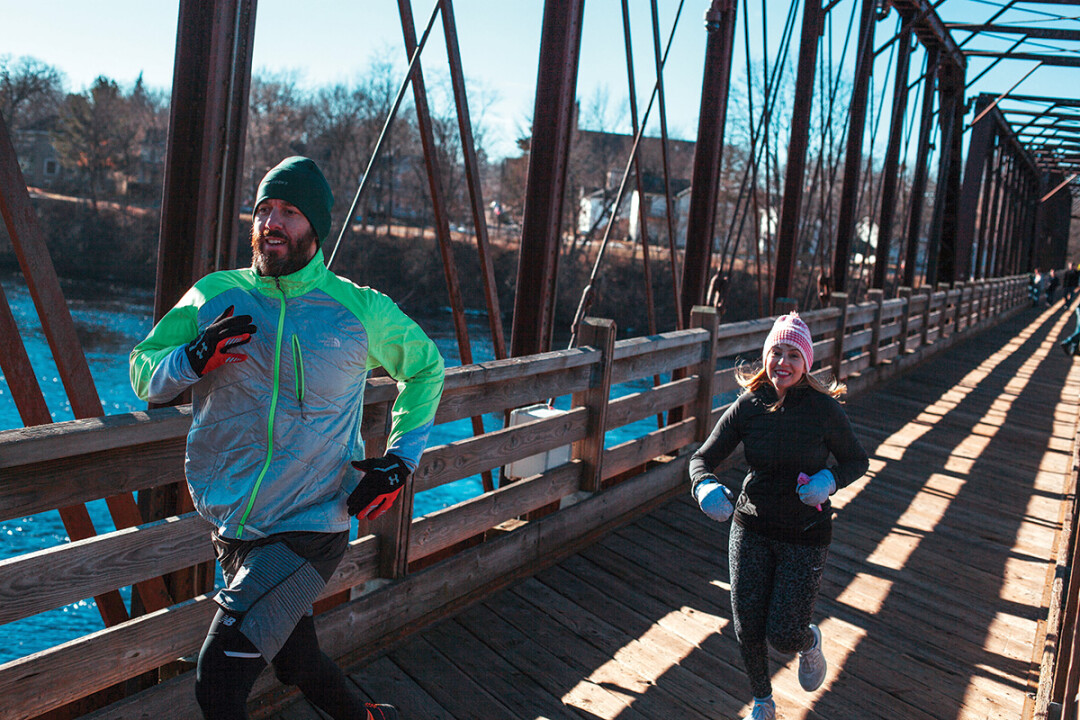The Right Steps for Winter
running during cold weather has benefits, but plenty of layers and a dedicated attitude are musts
Justine Childs, photos by Max Childs

The alarm goes off while it’s still dark. I stumble out of bed still foggy from the dream I was having and reach for the pile on my dresser I prepared the night before: fleece-lined leggings, two shirts, two pairs of socks, jacket, hat, gloves, shoes. It’s 6am and I am going running. In the winter. In Wisconsin. I check the temperature on my phone before heading out. It is 13 degrees and I am ready. The cold tries to creep up my back, and I feel it set in my legs and fingers on my first mile. I warm up and sort of dig the cold on my cheeks. I have been running outside since I started running and will only run inside if the temperatures go below -20. It’s all about the “want to” and the layers.
For most runners, running is a spiritual experience. It’s a need, a desire, or even therapy. It’s a way to connect with nature, a companion, or yourself. The “want to” is what drives a runner out the door when everyone else avoids it. And the mindset is preparing yourself that running in winter is different than running during other, more desirable months of the year.
Adam Condit, owner and operator of Blue Ox Running in downtown Eau Claire, agrees. “I’ve run through Wisconsin winters for over 20 years and have had my fair share of blizzards, icy roads, and sub-zero temperatures,” he says. “I remember it finally ‘clicked’ when I was warm on a 20-mile run in -10 temperatures that there are two main factors to having a successful winter run: mindset and gear.”
For most runners, running is a spiritual experience. It’s a need, a desire, or even therapy. It’s a way to connect with nature, a companion, or yourself. The “want to” is what drives a runner out the door when everyone else avoids it. And the mindset is preparing yourself that running in winter is different than running during other, more desirable months of the year.
“It is important to have a good mental outlook when being active through the winter so you know what to expect,” Adam says. “Your running pace will slow simply because of being more careful on ice or snow. Don’t worry about pace, but rather run on effort and time.”
This is the first year I have used a shoe with tread for snow and ice. Adam recommended a pair of Brooks that also had some rubber across the toe box, which help keep my feet warmer. I use two pairs of socks: a thinner pair against my skin and a longer pair I tuck my tights into to keep my ankles covered.
I use a fleece-lined pair of running tights, and when it dips below zero, I add another pair of windbreaker pants. I use two shirts under a jacket or my running vest, which I refer to as my “papoose.” The shirts need to be fitted: one long-sleeved and one tank or short-sleeved. I usually tuck one in my waistband to keep my core warm and happy. Cover your head and hands, and use a neck gaiter or face mask when it gets “really cold.”
The key is to find what works for you but DON’T OVERDRESS! You can’t run if you are wrapped up like Ralphie in A Christmas Story.
Adam agrees, “My experience says that if I’m warm during my first 10 minutes I’ll be overheating later in the run. Be prepared to be cold in your first 10-15 minutes of running so when your body temperature rises with activity you’re ‘just right’ for the remainder of your run.”
Winter running also increases chances you are running in the dark, so be extra cautious by wearing a reflector vest, using a headlamp, or clipping a blinking light on your jacket. Take it from someone who has been hit by a car while running: It’s worth the extra step to help a driver see you!
Blue Ox Running carries all different thicknesses of jackets, tights, base layers, neck warmers, gloves, hats, Gortex-covered trail shoes, and anything you would need for running in any conditions. Be safe, and have fun running in all seasons of our beautiful state of Wisconsin!

